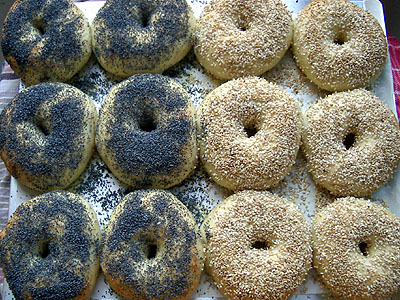
I don't know why, but I thought making bagels was considerably more complicated than making a loaf of bread. Well, it's not: it is easy.
A recipe and a description of how easy it was to make these below.
I knew making bagels involved boiling them. Somehow this left me with the impression that it would be as complicated as deep frying is, where you have to get the oil just the right temperature or else you end up either setting your kitchen on fire or eating little wet balls of grease. Plus there is the whole pot of grease clean up factor. Yuck. Not something I've wanted to deal with.
So when I read a couple of bagel recipes and all they said was "bring a pot of water to a boil. Drop bagels in and boil for a minute or two on each side" I... well, I felt like a dolt. Why didn't I try making these sooner?
About Bagels
There are a ton of bagel recipes out there. A large percentage of them include eggs and butter. Most suggest using high protein bread flour. Some include sugar, some include honey, and others include malt syrup or powder.
For my first time baking bagels, I decided to use the recipe from the The Bread Baker's Apprentice. It appealed to me because it had an extremely simple ingredient list (only one ingredient that don't routinely keep around the house, and it was simple to find and inexpensive) and included an overnight retardation of the dough that made it perfect for baking in the morning. As regular readers will recall, preparing bread in the evening for baking first thing in the morning is an ongoing desire of mine. This recipe fit that model perfectly.
Recipe
Makes 1 dozen bagels
Sponge:
1 teaspoon instant yeast
4 cups bread flour
2 1/2 cups water
Dough:
1/2 teaspoon instant yeast
3 3/4 cups bread flour
2 3/4 teaspoons salt
2 teaspoons malt powder
OR
1 tablespoon malt syrup, honey, or brown sugar
Finishing touches:
1 tablespoon baking soda for the water
Cornmeal for dusting the pan
Toppings for the bagels such as seeds, salt, onion, or garlic
The Night Before
Stir the yeast into the flour in a large mixing bowl. Add the water and stir until all ingredients are blended. Cover with plastic wrap and allow to rise for two hours.
Remove the plastic wrap and stir the additional yeast into the sponge. Add 3 cups of the flour, the malt powder (the one unusual ingredient, which I was able to find at the local health food store), and the salt into the bowl and mix until all of the ingredients form a ball. You need to work in the additional 3/4 cups of flour to stiffen the dough, either while still mixing in the bowl or while kneading. The dough should be stiffer and drier than normal bread dough, but moist enough that all of the ingredients are well blended.
Pour the dough out of the bowl onto a clean surface and knead for 10 minutes.
Immediately after kneading, split the dough into a dozen small pieces around 4 1/2 ounces each. Roll each piece into a ball and set it aside. When you have all 12 pieces made, cover them with a damp towel and let them rest for 20 minutes.
Shaping the bagel is a snap: punch your thumb through the center of each roll and then rotate the dough, working it so that the bagel is as even in width as possible.
Place the shaped bagels on an oiled sheet pan, with an inch or so of space between one another (use two pans, if you need to). If you have parchment paper, line the sheet pan with parchment and spray it lightly with oil before placing the bagels on the pan. Cover the pan with plastic (I put mine into a small plastic garbage bag) and allow the dough to rise for about 20 minutes.
The suggested method of testing whether the bagels are ready to retard is by dropping one of them into a bowl of cool water: if the bagel floats back up to the surface in under ten seconds it is ready to retard. If not, it needs to rise more. I didn't bother doing this, instead counting on it taking about 20 minutes to get my son's teeth brushed and get him to take a bath. In the quick interval between bath time and story time, I placed the pan into the refrigerator for the night.
Baking Day
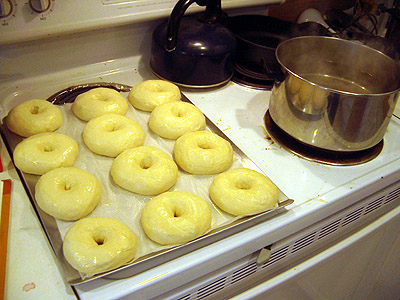
Preheat the oven to 500. Bring a large pot of water to a boil. Adding one tablespoon of baking soda to the pot to alkalize the water is suggested to replicate traditional bagel shop flavor. I went ahead and did this, though I have no idea if it made any difference.
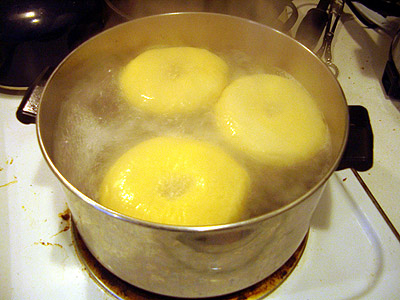
When the pot is boiling, drop a few of the bagels into the pot one at a time and let them boil for a minute. Use a large, slotted spoon or spatula to gently flip them over and boil them on the other side.
Before removing them from the pot, sprinkle corn meal onto the sheet pan. Remove them one at a time, set them back onto the sheet pan, and top them right away, while they are still slightly moist. Repeat this process until all of the bagels have been boiled and topped.
Once they have, place the sheet pan into the preheated oven and bake for 5 minutes. Reduce the heat to 450 degrees, rotate the pan, and bake for another 5 minutes until the bagels begin to brown. Remove the pan from the oven and let cool for as long as you can without succumbing to temptation.
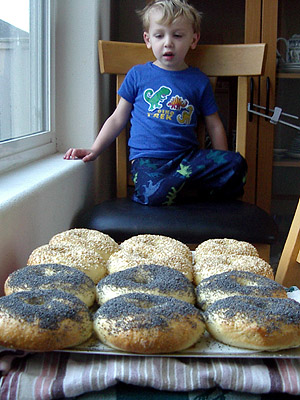
Wrap Up
These bagels were awesome. I may try a different recipe next time, like an egg bagel recipe, but I have no complaints about this one.
I did learn that you can put too many seeds on top of a bagel. I went particularly overboard with the poppy seeds. Next time I'll use a few less, but the bagels were still a hit with everyone.
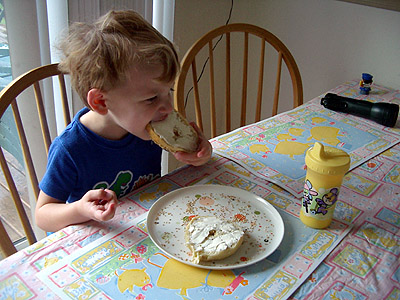
Related Recipes:Challah Bread, English Muffins, Struan Bread.
Comments
Brown rice syrup is maybe the next best thing as a sub for malt syrup. The agave would probably follow the others you mentioned along with molasses and brown sugar.
Being more accomplished as a homebrewer than a baker I ask- would one use the dry malt powder used in brewing work well here-I think so. What would the equivalent be ?
Don
I don't use instant yeast, but active dry yeast. Can it be used in this recipe, if I activate it first? I'd love to make bagels, and have seen so many delicious photos of homemade ones... oh boy it tickles be funky!
Sure!
I have made a number of batches of bagels using Hamelman's recipe, with some changes after trial and error. I live in Thailand and the bread flour here does not seem to be the same as in the states. So, to 2 pounds of bread flour, I add 2T of wheat gluten (surprisingly available here), and 2 t diastatic malt powder (which somehow found its way into my baggage after me last visit to the states). I bake the bagels on wooden planks, like I remember them doing in the bagel bakery in the Bronx, where I was raised. This seems to keep the bagel rounder and bake more evenly after flipping them over.
So, everything about the bagle is great...flavor, density, chewiness, shape, except the surface is not the smooth surface I remember bagels to possess. I even used different boiling times, with no difference.
As you can see in the photo, I also make bialys which look and taste exactly the way I remember.
Any insight or suggestions?
Hi folks, brand new to the site. I caught this post and figured why not begin by adding my 2 cents here ! I spent many years at the beginning of my cooking career working in a few of bagel shops here in NYC, one of which is just about the most famous you can think of. I noticed several replies on this post regarding the bottom of the bagel coming out too wet, and there is a very simple explanation for this. Traditionally, when the bagels are removed from the kettle, they are then tossed onto a series of boards ( basically 2x4's) covered with burlap. Once lined up on these boards they are slid one by one into the oven for approx. 1 minute. During this time the top of the bagel begins the drying and rising process. After the minute or so, which for most ovens is one revolution on their shelves, the bagels are then flipped off the boards and the boards removed. Aside from the boards being your vehicle for getting the bagels into the oven, they most importantly enable the bagel to dry and rise on one side before the flipping and continuation of baking. There is a very easy way to duplicate this process at home. I use a stone in my oven for the final bake, but prior to that I use sheet pan with a damp towel placed on top of it. After removing the bagels from the boiling water, place them on the towel/sheet pan combo, seed or dont seed, and place the pan on the rack above your stone for approx. 90 seconds depending on your oven. After this time, quickly remove the pan and place what had been the tops of the bagels face down on your stone. This process will give you a much more evenly cooked bagel throughout, with a nice rise and no " flat " side to your bagel.
I have been trying to make the perfect New York bagels for some time and I am very nearly there. My bagels look like they were just purchased from the bagel shop and they taste perfect. I do like them chewy, however, these are a bit TOO chewy. What do I do next? I bake them at 425 for 26 minutes. Should I reduce oven temperature to 400? Note: I make my bagels a little smaller than standard commercial ones.
Thanks for the help!
George
What brand and type of flour are you using?
Try a lower protein flour. If the lower protein flour doesn't make enough chew, then try various blends of your present flour and the lower protein flour until you get the desired chewiness.
There are tools available to calculate a desired protein level with various blends of flours, but of course that's probably not really necessary.
You can also play around with how long the bagels are allowed to rise, and/or the boiling times to get a bagel that is a little more "bready".
Ok, like many others I have never made bagels before. I made two batches. A whole wheat and a white / sessame seed version. My results were mixed.
1. The While Wheat bagles:
A. I used 50% Bread Flour (KA) and 50% Organic Stone Ground Whole Wheat (Bob's Red Mill)
B. I added about 1 teaspoon additional yeast and about 1/4 cup of additional water.
C. I also added a tablespoon or two of honey to the water alon with the baking powder.
D. I extended the boil time to 1.5 minutes on each side.
The result was a slighty crunchy, chewy, wonderful bagel. Now, I ate on while it was still hot. I did toast it and used a little butter and was quite pleased. The flavor was a bit lacking but according to the other posts the flavor may develop after they cool down a bit yet. I'll be trying another for dinner.
2. The White / Sessame Seed Bagels:
A. I followed the recipe exacty and the dough turned out a bit slack so I added a bit more flour.
B. I used corn meal on one pan and a cooking spray on another pan to prevent sticking and to see what the differences would be in the finished result.
C. I also added a bit of honey to the waer.
The result was less than what I had hoped for. The bagles that I used cooking spray on the pan were perfectly browned on top, however, the sooking spray prevented the bottoms from browing and as a result they were soggy on the bottoms.
The dough was a bit slack coming out of the fridge. They seemed to "fall" once I picked them up however they responded well to the water. They never regained their fullness and ended up bing sort of semi-flat / lumpy. The crust developed well, I like the look of these quite a bit.
On the pan that I used cornmeal as the stick preventer, for lack of a better term, the bottoms were perfect as expected.
Over all this was a great experiment and a well thoughout recipe. I really appreciate you posting it. I also appreciate the comments that the other uses added. This helped me fee more confidant in playing with the recipe a little. I'll do it again and make a few changes.
1. I'll bake them a bit longer
2. For the White / Sessame Bagels, I'll ensure the dough is a bit stiffer prior to shaping
3. I'll never used cooking spray again on bagles!
That is about it! Thanks again!!!
Patman
I've been having great success with this recipe with a couple of modifications. First - I am combing KA Bread Flour with enough Arrowhead Mills Vital Wheat Gluten to get it up to @ 14.5% Protein. I like the chewiness this gives me. I also found that my bagels would over-proof if I shaped them before retarding them. So now I mix the dough from the sponge and then retard in the bowl overnight. In the morning I punch down, portion & shape then let rest for ~30 mins. As soon as the Bagels are able to float in a glass of water I boil in Lye water (1 tsp Lye for each quart of boiling water). This gives me a crust that I've been unable to duplicate with Baking Soda or Barley Malt in the boiling water. I preheat to 500, but turn down to 450 and use convection when I put them in the oven.
I've been promising Tim(DH) for the past year or so that since I was loving making bread so much that I would totally be up for trying to make bagels sometime. As I was scanning over this post at about 10pm (not intending to be starting anything at that time of night) he looked over my shoulder and got excited asking if I was going to finally deliver on my promise of homemade bagels. I must admit, I was less than enthusiastic about starting them since our little one has been a VERY touchy sleeper lately, but I relented because I just can't say no to that childish glimmer in my husband's eyes :). So after briefly scanning the recipe I made the sponge (thinking that was the only part of the night before prep) and then I went to bed. I woke up at 6am the next morning and read the recipe again realizing my mistake and hoping that it wouldn't affect the outcome too badly. The only effect it seemed to have was that the crumb wasn't nice and tight and dense as you would expect from a bagel, it was slightly more open (like white bread), but these were still delicious. I used honey in the recipe and after a little research found that traditionally bagels are boiled in honey sweetened water with baking soda. So into the alkaline bath went the honey as well. Here are my yummy, crunchy results :)!
I'm a very novice baker, and had absolutely no idea that bagels are boiled during the process; I always assumed that bagels were nothing more than circles of bread. I'll have to give these a go.
Some years ago, I invented and trade-marked "Squagels", a square bagel.
"For a square meal eat a Squagel".
They won't roll off your table".
"We don't cut corners". etc.
We had a lot of fun, and when a large company made us an offer that we could not refuse, we sold Squagels for quite a lot of 'dough'.
Bagels are a passion of mine, and I have written extensively about the process. See my recipe and technique at:
http://kdwonders.blogspot.com/2012/02/bagels.html
Crumb is dense yet soft, taste is just what I remember growing up
The crust has just the right amount of crunch
Chef Reinhart is the greatest teacher. in all his books. I can't tell you how many times I have pulled out his books to reference a recipe.
Here is my batch that I finished this morning. They are so good and with it being so cold. What a treat.
First take on bagels and came out great. Soft on the outside, a little chewy inside (10pm and I could not resist eating one ...the butter just melted on it...drooling already)
I changed the recipe a little. Used half of the ingredients. Used honey (1Tbsp in the dough and 2 in the boiling water). Boiled 1.5min / side and baked about 8-9 min / side at around 475F. Retarded them in the fridge after forming for about 6 hours. I wasnt sure if they would rise but the came out quite big. I think next time I'll shape them a bit smaller
Overall I am very pleased with the taste and the result
I've never made bagels, but I've got my pretzels dialed in. Similarities between recipes include the boiling sodium bicarbonate bath, but for my pretzels I've come to use lye instead. (The purpose is to use an alkaline solution to denature the proteins on the surface so you get the maillard reaction while baking. The reason you have to boil the sodium bicarb is to enhance the denaturing since baking soda is a weak base. Sodium Hydroxide (lye) however, is a strong base and you can just dip in a room temp solution (30g to 1L water). Lye is a STRONG base though, wear eye protection and wash your skin immediately if it comes in contact. Be sure to keep it safe from kids and pets!)
I'm curious if the sodium bicarbonate part of this recipe is because of liability (you have to look long and hard to find someone willing to recommend since people can hurt themselves with lye) or if, for bagels, we don't want THAT much browning.
FWIW, I get my sodium hydroxide from Ace Hardware drain cleaning aisle. No, it's not "food grade". Works great. And none of my pretzel consumers have died. Yet.
Diastatic malt powder is commonly used for beer making. Try you local brewing supply stores to buy some for your bagel making!